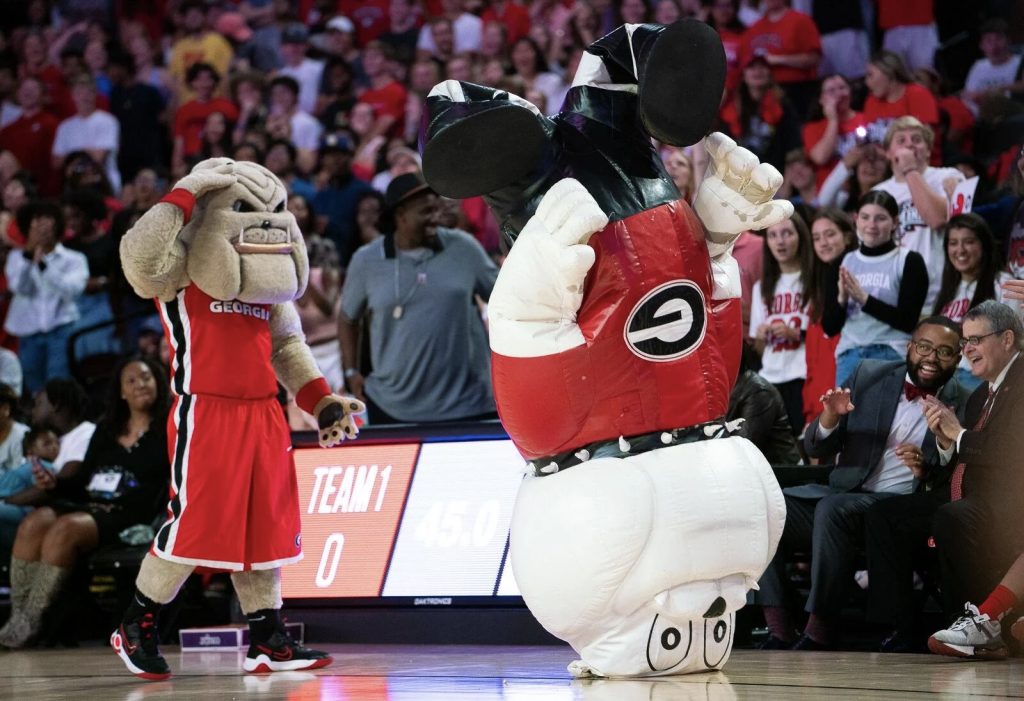Link to Article on The Red & Black
By Olivia Sayer

Spike and Hairy Dawg compete in a dance off on Oct. 7, 2022, in Athens, Georgia. The University of Georgia held its annual Stegmania at Stegeman Coliseum to preview the men’s and women’s basketball teams. (Photo/Sidney Chansamone, @sid.chansa)
At every sporting event, fans line up to take pictures with a popular person: the mascot. The University of Georgia has three mascots, with each one serving a different purpose.
The most well-known costume is that of Hairy Dawg. The fierce-looking Bulldog made his first appearance in the 1981 Sugar Bowl, where an undefeated Georgia beat Notre Dame 17-10 to secure its second national championship in program history. It was a well-timed debut for Hairy Dawg but not the first time the Bulldogs had a costumed mascot.
Former coach Mike Castronis, who served many roles through his Georgia tenure, introduced Fluffie Dog in 1975. It was the Bulldogs’ first costumed mascot, but with uneven eyebrows and floppy ears, Fluffie Dog was anything but intimidating. The goofy-looking Bulldog’s reign as mascot ended in the early 1980s when Hairy Dawg made his first appearance.
Hairy Dawg began as an idea from local ad man Don Smith, but with a slight change. Similarly spelled “Harry Dog” appeared in newspapers from around 1960-1980 with the intention of pummeling his opponents. The illustrations would often show Harry Dog with a bat or frying pan in hand as he opposed either a Gator, Gamecock or whoever else the Bulldogs were playing.
“As a kid, that’s how I started my Saturdays,” Kirk Smith, son of Don Smith, told Dawg Nation. “I’d run to get the paper and see Harry at top of the fold.”
Although Harry Dog became a popular attraction in Athens, the legend says it did not directly play into the creation of today’s Hairy Dawg. According to former Georgia promotions director Avery McLean, the credit should be given to Tom Sapp, who drew him in 1968 as what he later described as a “bulldog with bulging muscles” for a business fraternity.
Hairy Dawg is often joined by Uga, the live mascot that draws a roaring ovation whenever he is shown to the crowd. Uga made his inaugural appearance in 1956 when Uga I took the sideline for his first game between the hedges.
Georgia is now on its 11th Uga, as the Bulldogs introduced a spry puppy named “Boom” at the annual G-Day spring game in 2023. He replaced “Que,” whose 91-18 record made him the winningest Bulldog in Georgia history.
While Uga typically sticks to football, Hairy Dawg is at the majority of sporting events. For events in Stegeman Coliseum, he is joined by Spike, the inflatable mascot whose sole purpose is to entertain and occasionally confuse.
Throughout games, Spike can be seen bopping fans in attendance with his head, dancing on the basketball court or roaming the stands. Spike elicits the loudest cheers when he flips upside down to stand on his head while jumping.
“I really love messing with people just to see their reaction,” former costume wearer Austin Lashley said in a Red & Black story from 2018. “A lot of times people, for some reason, think that Spike is a robot or like a plugged-up inflatable. Sometimes I’ll just stand there and not move at all until they get near me, and then I’ll jump out at them and they’ll figure out I’m real, and it’s just the best reaction.”
Spike was first introduced in 1998 to serve as volleyball’s mascot. However, the inflated Bulldog that wears striped shorts and possesses a memorable stare can now be seen at basketball and gymnastics events as well.
Spike, Hairy Dawg and Uga all put smiles on people’s faces, contributing to the historic gameday environment. Next time you are at a sporting event, pay close attention to the mascots, as there is a chance they will do something special.